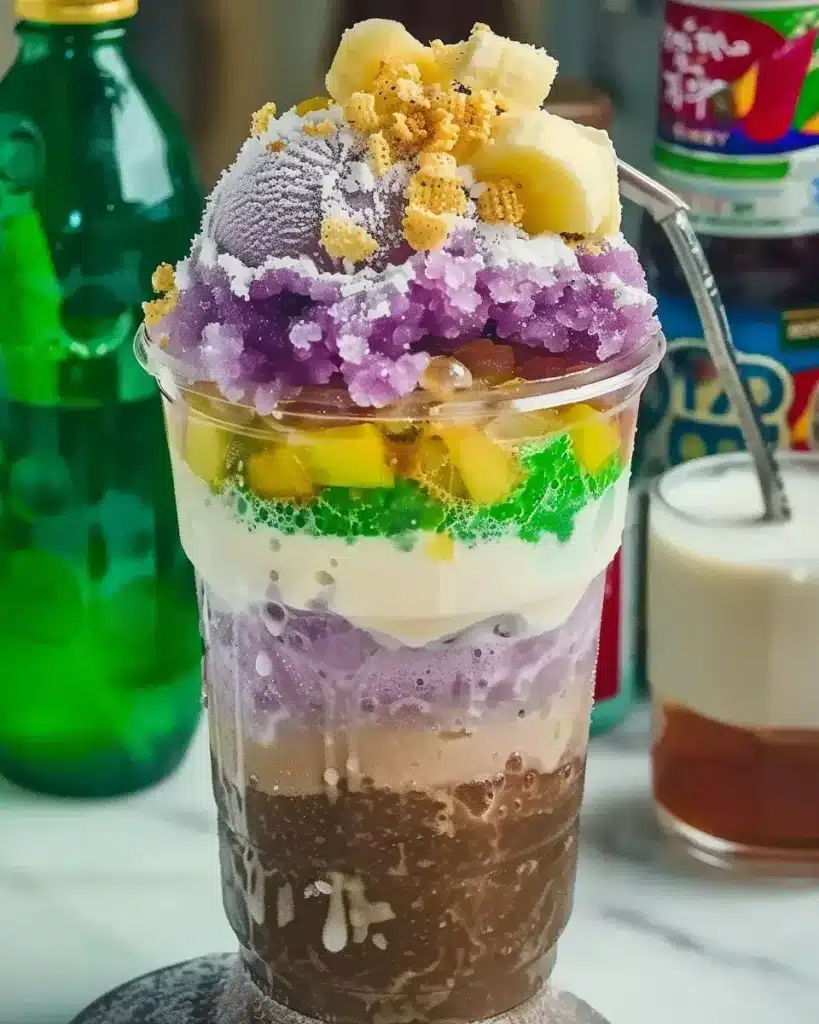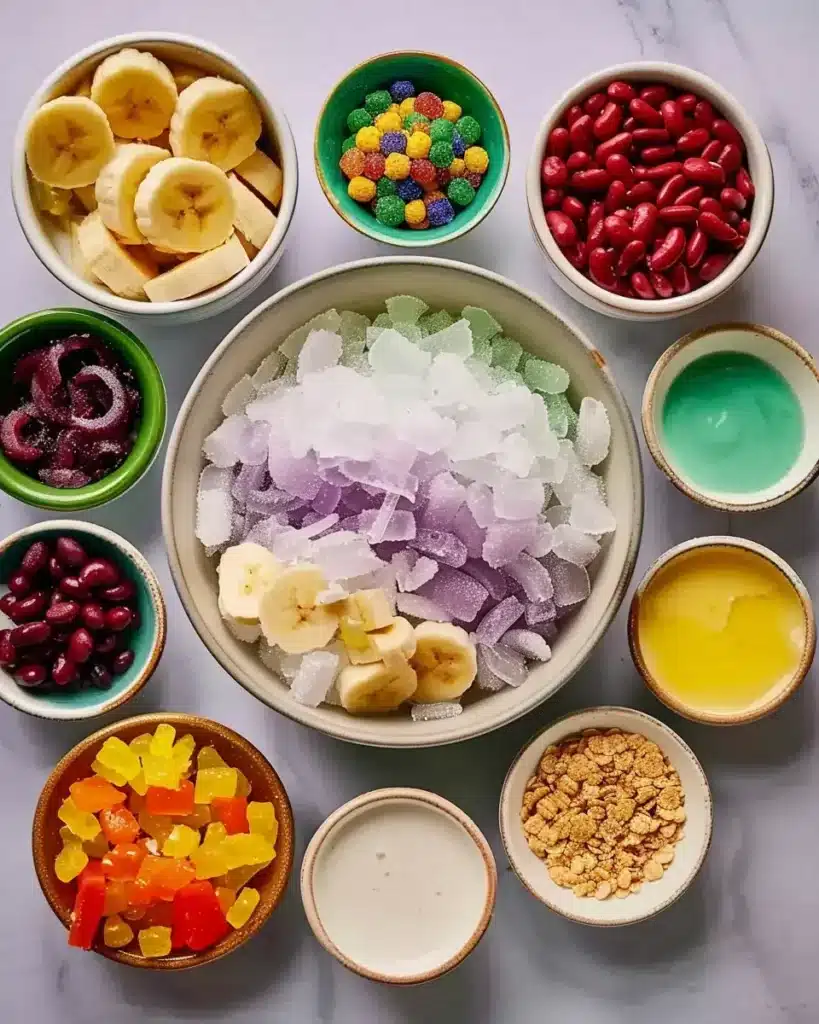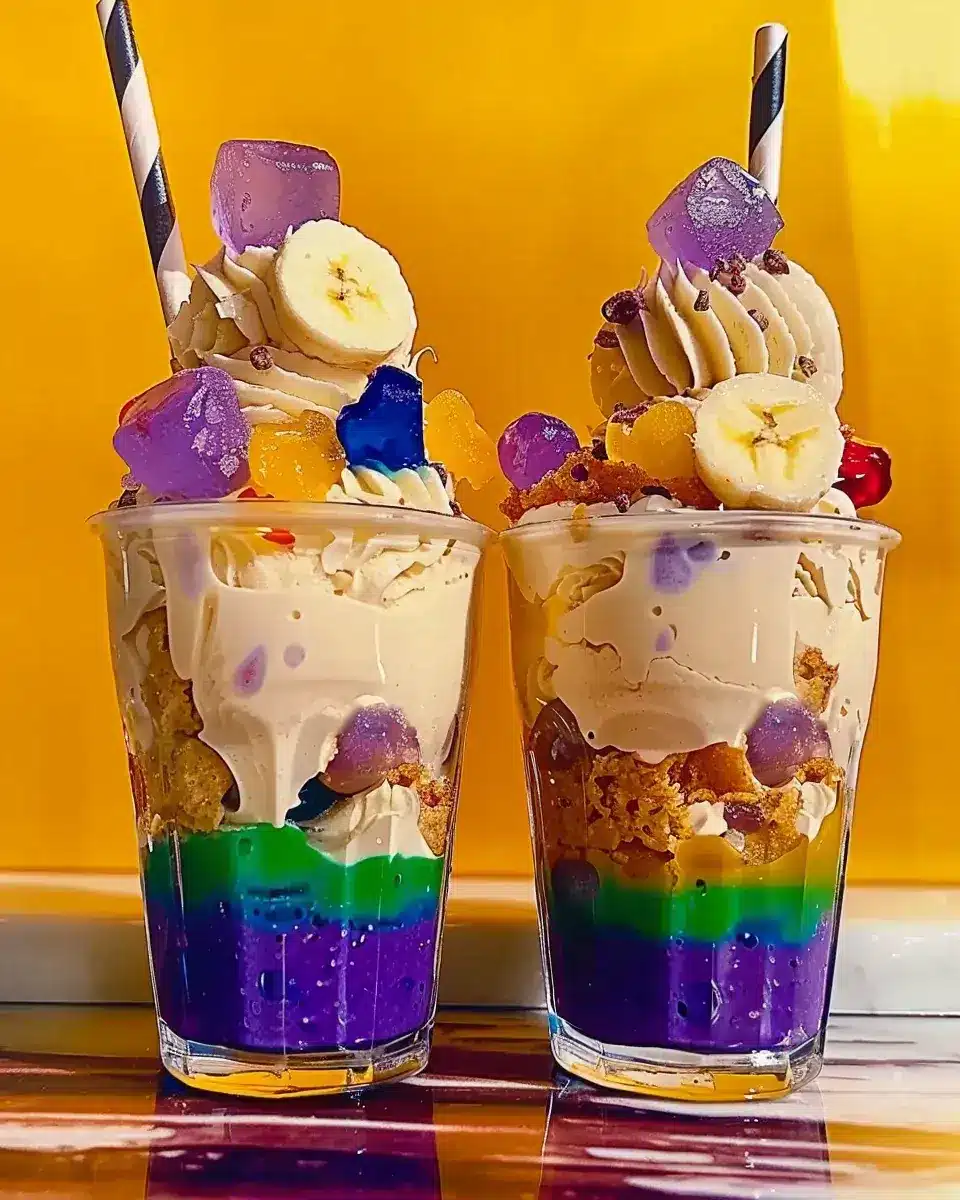Filipino dessert halo-halo is more than just a cold treat, it’s a vibrant, texture-packed experience that turns every bite into a summer celebration. Ice cream is great, snow cones are fun, but nothing compares to the icy, creamy, chewy chaos that is halo-halo. I first discovered it during a family potluck in my twenties, and I’ve been hooked ever since. Since then, I’ve tracked down halo-halo across Filipino restaurants here in the U.S. and tasted some unforgettable ones in the Philippines, too.

I’m Riley Moore, a self-taught home cook from Asheville, North Carolina. I grew up around comfort food, my grandma’s pies, my dad’s smoky ribs, and plenty of kitchen “oops” moments, like when I nearly destroyed a skillet making pancakes at age seven. These days, I focus on easy, flavor-forward recipes you can count on, and Filipino dessert halo-halo fits right into that mission. It bursts with color, brings pure joy, and is much easier to make than you’d expect.
The first time I mixed up a glass of Filipino dessert halo-halo, it felt like a dessert adventure. Layers of tropical fruit, chewy coconut jelly, sweetened bananas, and fluffy shaved ice, all swirled together with creamy milk and a scoop of ice cream. It was like tasting sunshine in every bite. That experience sparked the idea to craft my own halo-halo recipe, shaped by the most memorable versions I’ve tasted and recreated in my own kitchen.
This post is more than just a recipe, it’s a celebration of sweet flavors, summer joy, and the beauty of homemade food. Whether you’re new to Filipino dessert halo-halo or looking to recreate the dessert of your childhood, I’m here to help you layer, scoop, and mix your way to dessert bliss.
Table of content
A Sweet Story Behind Filipino Dessert Halo-Halo
From First Spoonful to Summer Staple
My love for Filipino dessert halo-halo grew slowly, and then all at once. I remember standing at a small food stall in Manila, sweat dripping, as the vendor piled layers of banana in syrup, bright jellies, and shaved ice into a tall glass. One bite in, and I was spellbound. The textures! The flavor! The way the ube ice cream melted into the creamy milk and coconut, it was unlike any dessert I’d had before.
Back home in North Carolina, I began recreating that moment, experimenting with ingredients I sourced from Filipino markets and online shops. After several test runs (and lots of enthusiastic taste-testing from friends), I landed on my perfect version. And now, I’m thrilled to share it with you.
What Makes Halo-Halo So Special?
The name “halo-halo” comes from the Tagalog word meaning “mix-mix,” which is exactly what you do before diving in. This popular Filipino dessert starts with a base of shaved ice, layered with various sweetened fruits, jellies, beans, and creamy toppings like leche flan or ice cream. Once mixed, every bite is a little surprise, chewy, creamy, crunchy, icy with a flavor that dances between coconut, caramel, vanilla, and tropical fruit.
While Filipino dessert halo-halo has roots in Japanese kakigori, it has evolved into something uniquely Filipino. You’ll find halo-halo served in humble street carts and upscale hotel buffets alike. What’s inside changes from region to region, and home to home. Some people add red mung beans, others include corn, but everyone agrees: the more textures, the better.
Want to explore more comfort-style sweets like this? Stop by the Home page to browse desserts, pies, and classic recipes with bold flavor.
For a look into why I believe food should be simple, comforting, and full of joy, visit About Riley Moore.
The Must-Have Mix-Ins That Make It Shine
The true joy of Filipino dessert halo-halo is in the mix-ins, those layers of sweet, chewy, creamy, and icy ingredients that surprise you with every spoonful. What goes into a halo-halo depends on who’s making it, but a few components show up in almost every beloved version.
Let’s start with the heart of the dessert:
Sweetened bananas, known as minatamis na saging, are an essential layer in the mix. These are usually saba bananas (or regular bananas in a pinch) simmered in a brown sugar syrup. They soak up the caramel-like liquid and bring a soft, almost jammy texture to your halo-halo. In my version, I stir in small tapioca pearls for an extra layer of chew.
Macapuno comes next, a tender, jelly-textured coconut that adds a sweet, chewy bite to the dessert. It’s a traditional favorite in many Filipino desserts. I enjoy how it pairs with the firmer texture of nata de coco, a chewy jelly derived from coconut water fermentation.
Another standout is ube halaya, a thick purple yam jam with a rich, nutty sweetness and striking violet color. Some people use ube ice cream, but I prefer ube halaya for its bold flavor and wide availability.
Jackfruit, or langka, adds brightness and bite. It’s slightly firm, with a sweet floral taste that balances the creaminess of the other ingredients. I chop canned jackfruit in syrup into small chunks so every bite delivers a pop of flavor.
Looking for more ingredient ideas or sweet inspiration? Check out the Desserts category for more tropical treats and easy homemade favorites.
Milk and Ice Cream: The Creamy Finish
No halo-halo is complete without the milk drizzle and that perfect scoop of ice cream. I use a mixture of coconut milk, evaporated milk, and sweetened condensed milk to give the dish that lush, leche flan-inspired flavor. If you’re dairy-free, coconut-based condensed milk is a great swap.
When it comes to ice cream, go with what complements your flavors. Coconut ice cream works beautifully, as does ube if you can find it. Mango sorbet or even vanilla ice cream also play nicely with tropical mix-ins. Vegan? A scoop of non-dairy coconut or cashew-based ice cream gets the job done without compromising texture.
Here’s a quick view of some favorite components and what they add to the halo-halo experience:
Print
Filipino Dessert Halo-Halo: Ultimate Summer Treat You Must Try
- Total Time: 35 minutes
- Yield: 4 servings 1x
- Diet: Vegetarian
Description
This Filipino dessert halo-halo recipe layers sweet fruits, coconut, and ube halaya with shaved ice and ice cream for the ultimate summer refreshment.
Ingredients
1/4 cup small tapioca pearls (optional)
3 saba bananas or 2 regular bananas
1 cup water (plus more for tapioca)
3/4 cup packed light brown sugar
1/4 tsp kosher salt
1/4 tsp vanilla extract
1 (20 oz) can jackfruit in syrup
2/3 cup canned full-fat coconut milk
3 tbsp evaporated milk
3 tbsp sweetened condensed milk
1/2 cup macapuno
1/2 cup ube halaya
1 1/2 cups nata de coco
4 scoops coconut or ube ice cream
4 cups shaved ice
Instructions
1. Bring a saucepan of water to boil. Add tapioca and cook 7–8 mins until translucent. Drain.
2. Slice bananas into 1/4-inch rounds.
3. Simmer water, sugar, salt, and vanilla to make syrup.
4. Add bananas, simmer 5 mins until soft and glossy.
5. Stir in tapioca and refrigerate until cold.
6. Chop jackfruit and return to syrup.
7. Mix coconut milk, evaporated milk, and condensed milk.
8. In each glass, layer 1/3 cup sweetened banana mix, then add ube, macapuno, jackfruit, nata de coco.
9. Top with shaved ice and drizzle milk mixture.
10. Finish with a scoop of ice cream. Mix before eating.
Notes
Use coconut-based milk and vegan ice cream for a dairy-free version.
Prep mix-ins ahead of time and keep chilled for faster serving.
- Prep Time: 15 minutes
- Cook Time: 20 minutes
- Category: Dessert
- Method: No-Bake
- Cuisine: Filipino
Nutrition
- Serving Size: 1 glass
- Calories: 420
- Sugar: 38g
- Sodium: 80mg
- Fat: 14g
- Saturated Fat: 10g
- Unsaturated Fat: 3g
- Trans Fat: 0g
- Carbohydrates: 65g
- Fiber: 2g
- Protein: 3g
- Cholesterol: 15mg
Every ingredient brings something different to the table, and that’s what makes Filipino dessert halo-halo so personal and exciting to eat. Mix and match, try new things, and find your own favorite combo.
How to Make Filipino Dessert Halo-Halo at Home
Prep the Sweet Bananas and Tapioca Pearls First
To get started on your homemade Filipino dessert halo-halo, begin with one of the foundational layers: sweetened bananas with tapioca pearls. This mixture adds a soft, syrupy, caramel flavor that anchors all the bright, tropical elements of the dessert.
Here’s how to do it:
- Cook the tapioca pearls. In a medium saucepan, bring water to a boil. Stir in the small tapioca pearls and cook until mostly translucent, around 7–8 minutes. Drain and rinse to cool.
- Slice the bananas. Use saba bananas if available (or regular ripe bananas). Slice into ¼-inch rounds.
- Make the syrup. In another saucepan, combine water, light brown sugar, a pinch of salt, and a splash of vanilla extract. Simmer for about 5 minutes.
- Simmer the bananas. Add the banana slices to the syrup and gently cook until they turn glossy and soft, about 5 minutes more.
- Combine and chill. Stir in the tapioca pearls and let the mixture cool. Refrigerate until fully chilled before assembling.
This banana-tapioca combo can be made a day ahead and stored in the fridge. It thickens slightly as it cools, making it even better when layered into the halo-halo.
Layering the Classic Filipino Dessert Halo-Halo
Once your sweet banana base is ready, it’s time to build your glass of halo-halo. You can mix and match ingredients based on what you enjoy, but here’s my tested combination that balances texture, sweetness, and creaminess:
- Chopped jackfruit in syrup – Bright, tropical, and slightly firm.
- Macapuno – A tender, sweet coconut strand with a jelly-like chew.
- Ube halaya – Rich purple yam jam that adds earthy sweetness and a pop of color.
- Nata de coco – A firm, chewy jelly made by fermenting coconut water.
- Milk blend – A mix of coconut milk, sweetened condensed milk, and evaporated milk for a creamy drizzle.
- Coconut or ube ice cream – To crown your glass with creamy indulgence.
Here’s how to put it all together:
- Add the banana and tapioca mixture (about 1/3 cup) to the bottom of a 16-ounce glass.
- Layer in 2 tablespoons each of macapuno, ube halaya, and chopped jackfruit.
- Spoon in 1/3 cup nata de coco.
- Top with a big scoop of shaved ice (about 1 cup).
- Drizzle with 3 tablespoons of the milk mixture.
- Finish with a scoop of coconut or ube ice cream on top.
If needed, add extra shaved ice to fill the glass. Serve immediately the Filipino dessert halo-halo with a long spoon, and don’t forget to mix it all up before eating!
Want a visual? I share a similar layering process in other dessert recipes on my Dessert page, where comfort food and creativity meet.
Serving Filipino Dessert Halo-Halo
Creative Ways to Serve Halo-Halo for Any Occasion
One of the best things about Filipino dessert halo-halo is how easily it adapts. Whether you’re serving one or ten, it’s a showstopper, both in flavor and appearance. The layers, textures, and bright colors make it a dessert that sparks conversation.
Hosting a dinner party? Use mason jars or clear parfait glasses to layer individual servings ahead of time. Then keep them in the fridge and add shaved ice and ice cream right before serving.
For a casual summer get-together, try a halo-halo bar. Set out bowls of each topping, jackfruit, macapuno, nata de coco, ube halaya, along with crushed or shaved ice and pitchers of the milk mixture. Guests can build their own, mixing and matching as they please.

Need to go dairy-free or vegan? Swap in coconut condensed milk and a non-dairy evaporated milk, and top it off with a scoop of vegan coconut or cashew-based ice cream. It’s just as creamy and satisfying.
Want to make it kid-friendly? Skip the ube halaya and offer fruit-forward toppings like mango cubes, strawberries, or sweet corn. Kids love the icy crunch and layered sweetness, just give them a long spoon and let them dig in.
More comforting, crowd-pleasing desserts are waiting for you over on my Recipes page, from pies to puddings to tropical twists just like this one.
A Chilled Classic Worth Mixing Into Your Summer
Whether it’s your first time trying it or your hundredth glass, Filipino dessert halo-halo always feels like a celebration. Each spoonful delivers something new, sweet fruit, chewy jelly, creamy ice cream, and icy goodness, and that’s what makes it magical. This isn’t just a dessert; it’s an invitation to play, to mix, and to experience joy one layer at a time.
I hope this recipe brings a bit of that joy to your kitchen, the same way it did for me. If you’re looking for more comfort-forward treats with bold flavors and easy steps, head over to the Recipes section. There’s always something cooling, cozy, or completely crave-worthy waiting for you.
Now go ahead, grab that tall glass, pile in the mix-ins, and make your own halo-halo moment. You’ve got everything you need.
For more recipes follow me on pinterest and medium
Frequently Asked Questions About Filipino Dessert Halo-Halo
What is Filipino dessert halo-halo made of?
Halo-halo is made of shaved ice, evaporated or condensed milk, and a variety of mix-ins like sweetened bananas, jackfruit, macapuno, nata de coco, ube halaya, and topped with ice cream or flan. It’s all about texture and flavor variety in one icy glass.
What is the Philippines halo-halo?
In the Philippines, halo-halo is a beloved summer dessert served everywhere from street vendors to five-star hotels. The name means “mix-mix” in Tagalog, referring to how the ingredients are stirred together before eating.
What is the famous Filipino dessert?
Halo-halo is one of the most iconic Filipino desserts, along with leche flan, bibingka (rice cake), and ube halaya. It’s especially popular during the hot season because of its refreshing, icy base and colorful mix-ins.
Why do Filipinos love halo-halo?
Filipinos love halo-halo because it celebrates the diversity of ingredients found in the country, from coconut to yam to tropical fruits, and turns them into a joyful, shareable experience. It’s nostalgic, customizable, and deliciously cooling on hot days.
Ready to try your hand at this ultimate tropical dessert? If you’re craving something cool, creamy, and colorful, Filipino dessert halo-halo might just become your new favorite.

